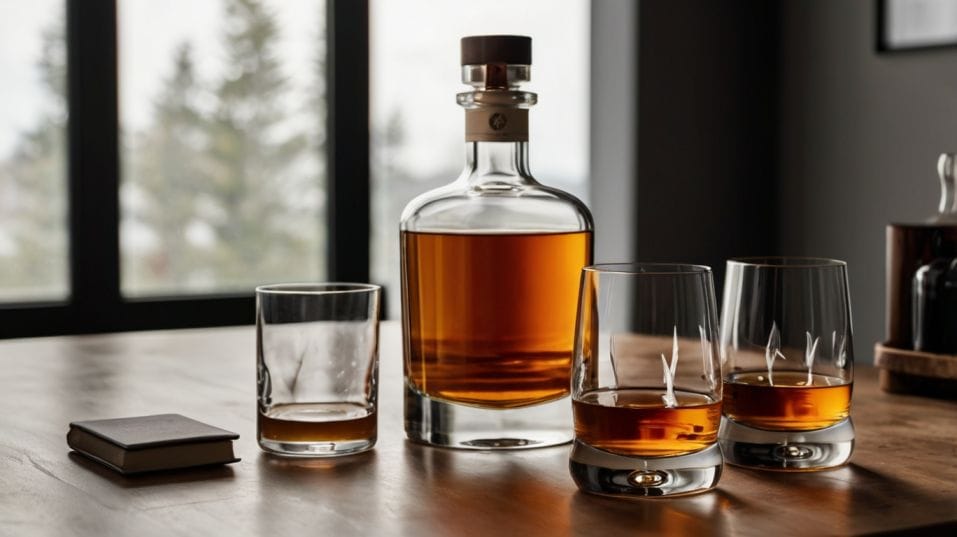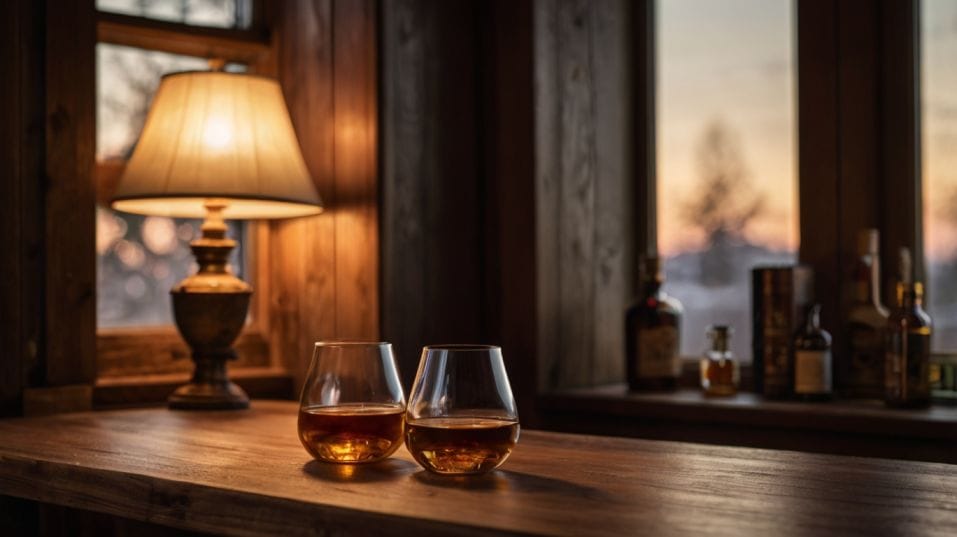Your First Home Whiskey Setup: A Quick Guide
Ready to build your first whiskey setup? Learn how to taste smarter, collect with purpose, and grow your palate—one pour at a time.

Are you ready to actually taste whiskey—not just drink it? If you’ve outgrown guesswork and want to build a setup that sharpens your palate and boosts your confidence, this guide is your launchpad.
We’ll strip away the noise and show you what really matters: the tools, techniques, and mindset that turn casual sipping into intentional tasting. No fluff, no flexing—just a smarter way to start your whiskey journey.
Start With the Right Glass—Because It Changes Everything
Forget the heavy-bottomed tumblers. They’re fine for cocktails and casual sipping, but if you’re serious about tasting, they’re working against you.
Whiskey flavor starts in the nose, not the tongue. You need a glass that narrows at the top to capture and concentrate aroma.
A Glencairn is the go-to for a reason—it’s engineered to enhance the sensory experience. Copitas and tulip-shaped tasting glasses work just as well.
You don’t need a whole shelf of stemware. You need one good glass that doesn’t get in the way of the whiskey.
Once you make the switch, you’ll notice aromas you never picked up before. That’s not magic—it’s mechanics. This one change alone will improve your tasting skills more than any bottle ever will.

Curate With Intention—Not Hype
Don’t chase quantity. Don’t chase collectibility. Build your first lineup with purpose. You want range, not redundancy.
You’re not creating a museum—you’re creating a flavor lab. A good starting point? Choose whiskeys that contrast each other in style, region, grain, and proof.
A high-rye bourbon will show you spice and punch. A soft wheat bourbon brings out sweetness and subtlety. A smoky Islay Scotch hits you with peat, while a Speyside malt will speak in honey and fruit.
Japanese, Irish, American single malt—each broadens your reference points. Each pour becomes a comparative tool. When you drink for difference, your palate learns fast.
And no, you don’t need to spend big. You need to spend smart. Seek out whiskeys known for clarity, balance, or bold profiles—not flashy packaging or collector buzz.
You're not trying to impress anyone. You’re trying to understand what’s in the glass.
Master Time, Temperature, and Patience
You’re not pouring soda. Whiskey has range. Temperature affects aroma. Time changes taste. Pour a glass and wait.
A few minutes of oxygen contact can loosen a tight nose and mellow the burn. It’s called “opening up,” and it’s not just a phrase—it’s chemistry.
Cooler temperatures (mid-60s Fahrenheit) are ideal. Too warm, and the alcohol overpowers everything. Too cold, and you lose aroma complexity.
If your room’s too hot, don’t be afraid to cool your glass slightly—just avoid ice right away if you’re tasting.
Sip it once. Wait. Smell again. Take a second sip. You’ll notice it starts to evolve. What tasted harsh or bland may soften into something surprising. Whiskey rewards patience. If you’re rushing through a pour, you’re wasting it.
Learn What Water and Ice Actually Do
Adding water isn’t sacrilege. It’s smart. Especially when you're dealing with higher-proof whiskey, a few drops can unlock flavors trapped by alcohol intensity.
The key is precision. Add slowly. Taste between drops. Pay attention to the shift—it’s often dramatic.
Ice is trickier. It lowers temperature, which mutes aroma but softens harshness. That’s not good or bad—it just changes what you experience. Use a large, clear cube that melts slow. Avoid crushed ice or “whiskey stones”—they don’t add value.
Use water or ice with intent. Not because someone else said it’s right or wrong, but because you understand what each choice does. That’s the mark of a developing palate.
Build a Flavor Vocabulary—Your Way
Most people drink on autopilot. They can tell you if they like something, but not why. That’s where a simple tasting journal becomes powerful.
Skip the dramatic notes (“charred leather,” “wet tobacco barn at dawn”). Just track what stood out: sweetness, spice, heat, balance, length.
Write what you taste, feel, and notice. Keep it honest. Use your own terms. Over time, you’ll see patterns.
You’ll realize you prefer nutty over fruity, or you like the oiliness of some Scotch more than the dry snap of rye. This is how you stop drinking randomly and start drinking with clarity.
You’ll also build memory. What seemed vague months ago will become sharp. You’ll remember which distilleries hit your sweet spot and which ones fall flat.
That notebook becomes your personal flavor map—and no app can compete with that.
Create a Space That Sharpens Focus
Your environment impacts your perception. You don’t need a velvet lounge or moody jazz. But you do need intention. Bright light helps you observe color and clarity.
Silence—or soft, neutral sound—helps you focus on flavor. Sipping whiskey in a crowded room with your phone buzzing isn’t tasting. It’s distraction.
If you want to train your palate, give whiskey your full attention—even for five minutes. Eliminate competing smells. Don’t taste right after eating heavily spiced food.
Rinse your mouth with water before diving in. These small adjustments add up. They create conditions where you can notice what your senses are telling you. This is about respect—for the whiskey, and for your own learning process.
Respect the Process—But Make It Yours
You’re not trying to be a sommelier. You’re not joining some whiskey cult.
You’re developing a skill that sharpens your senses, deepens your enjoyment, and gives you a clearer sense of what you like. That doesn’t require rules. It requires repetition.
So taste often—but taste mindfully.
Swap pours with friends. Blind test yourself. Return to old bottles and re-evaluate. Your palate will evolve. So will your preferences. And that’s the whole point. This isn’t about arriving. It’s about discovering.
Final Thoughts
Your first home whiskey setup isn’t just about gear or glassware. It’s about building a system that helps you taste better. Use a proper glass.
Curate bottles that challenge and contrast. Learn how temperature, time, water, and even your surroundings shape flavor.
Take notes. Reflect. Get better with each pour. You don’t need permission to begin. You need curiosity—and a little discipline.
So here’s your next move: Clear your evening. Pick one bottle. Pour a glass. Taste it like it matters. Because it does. Every time you pay attention, you level up.
Build your setup. Train your palate. Trust your experience. Start tonight.




